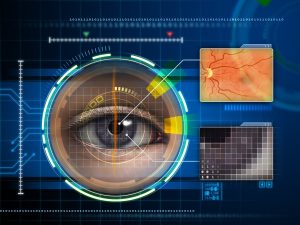It’s the part of the eye exam everyone hates: the pupil-dilating eye drops. Your eyes remain blurry for several hours afterwards, often making the process inconvenient for both patient and doctor. The reason for the dilation is to keep the iris from constricting, and is used for routine examination and to photograph the back of the eye.
Recently, researchers at the University of Illinois at Chicago College of Medicine along with the Massachusetts Eye and Ear/Harvard Medical School, developed an inexpensive, portable retina camera that can take images of the retina without the need for pupil-dilating drops.
“As residents seeing patients in the hospital, there are often times when we are not allowed to dilate patients — neurosurgery patients for example,” said Dr. Bailey Shen, a second-year ophthalmology resident at the UIC College of Medicine. “Also, there are times when we find something abnormal in the back of the eye, but it is not practical to wheel the patient all the way over to the outpatient eye clinic just for a photograph.”
The prototype retina camera, which is pocket-sized, can take pictures of the back of the eye without eye drops, Shen says. The pictures can be shared with other doctors, or attached to the patient’s medical record.
The retina camera works by first emitting IR light, to which the iris does not react. Most retina cameras use white light, which is why pupil-dilating eye drops are needed. The IR light is used to focus the camera on the retina, which can take a few seconds. Once focused, a quick flash of white light is delivered as the picture is taken. Currently, there are cameras that use this same IR/white light technique, but they are bulky and often cost thousands of dollars. The prototype’s total cost was roughly $185.
The camera is based on the Raspberry Pi 2 computer, a low-cost, single-board computer designed to teach children how to build and program computers. The board hooks up to a small, low-cost infrared (IR) camera, and a dual IR- and white-light-emitting diode (LED). The camera also includes a lens, a small display screen, and several cables.
As the field of medicine and technology grows, the need for accuracy and reliability in design and manufacturing becomes more and more important. At UKA, we specialize in developing precision lenses for all types of imaging systems, like a retina camera. All our work is done in-house, thereby guaranteeing your design is manufactured to your exact specifications.
“The device is currently just a prototype, but it shows that it is possible to build a cheap camera capable of taking quality pictures of the retina without dilating eye drops,“ Shen said. “It would be cool someday if this device or something similar was carried around in the white-coat pockets of every ophthalmology resident and used by physicians outside of ophthalmology as well.”
Universe Kogaku designs and manufactures optical lenses for medical cameras, security, high tech and electronic applications. We stock 1000’s of standard lens assemblies and can custom design a solution for scanners, CCTV, CCD/CMOS, medical imaging, surveillance systems, machine vision and night vision systems.